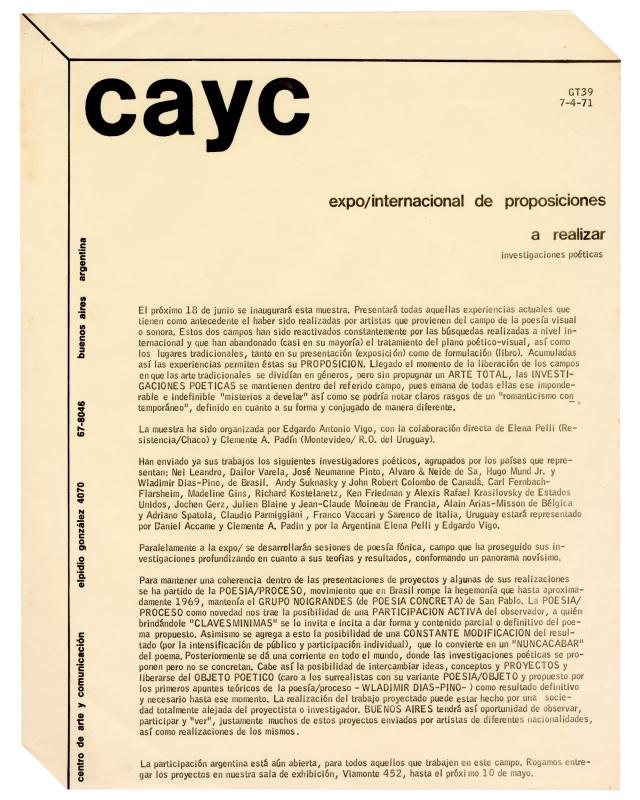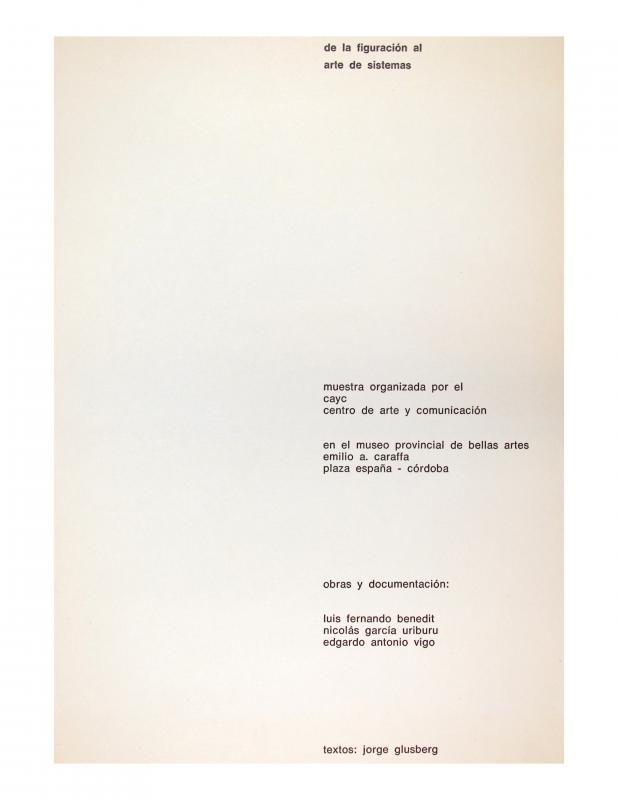Ever since it was founded, the CAYC (Centro de Arte y Comunicación), helmed by the cultural promoter, artist, and businessman Jorge Glusberg, was intended as an interdisciplinary space where an experimental art movement could flourish. The establishment of collaborative networks connecting local and international artists and critics played a key role in this process. The exhibitions shone a light on these exchanges, in which overviews of trends or individual artists introduced the innovations of international contemporary art and made Argentine and Latin American artists better known on the global scene.
Over the course of his varied career, Edgardo Antonio Vigo (1928–97) created objects, prints, signs, mail art, and visual poetry. He started the magazines Diagonal Cero (1961) and Hexágono (1971). In 1969 he organized the Expo/Internacional de Novísima poesía/69, which brought together experimental artists from all over the world to present works that ranged from visual poetry to electronic media used in the performance of sound poetry. This exhibition was a clear forerunner to the one that took place at the CAYC in June 1971. [For more information about the Expo/Internacional de Proposiciones a realizar. Investigaciones poéticas,see GT-39 (doc. no. 1476286">1476286)].
Vigo was a regular participant in the CAYC’s activities, from the center’s founding in 1968 until the mid-1970s. He was one of the three artists invited to take part in De la Figuración al Arte de Sistemas (1970) [doc. no. 761141], the exhibition that the CAYC presented at the Museo Emilio Caraffa in Córdoba, where the category of “systems art” was first mentioned. When the Grupo de los Trece was started in 1971, however, Vigo did not join the group, although he remained involved with the center in a relationship based on mutual collaboration. He found the environment at the center to be compatible with his own discourse and actions, both in terms of his experimental work and his ideological convictions concerning the struggle for the political and economic freedom of Latin American countries.
With a focus on the sort of poetry that Vigo was producing and the works of the Uruguayan poet Clemente Padín, the Expo/Internacional de Proposiciones a realizar.Investigaciones poéticas presented a number of experimental practices that demonstrated the extensive collaboration that existed among artists and underscored the innovative nature of these “propositions” that were so different from other forms of poetry in circulation because of the active involvement of the attendees. The name of the exhibition confirmed the fleeting, transitory, and even nonexistent quality of the collection of works on display: “plans for exploration in the field of poetry are proposed but never actually implemented, thus creating the possibility of an exchange of ideas, concepts, and PROJECTS and being liberated from the POETIC OBJECT […] as a final and necessary result” (Centro de Arte y Comunicación, Expo/ Internacional de proposiciones a realizar [sic], GT-39 (doc. no. 1476286">1476286), Buenos Aires: Centro de Arte y Comunicación, 7-4-71).


